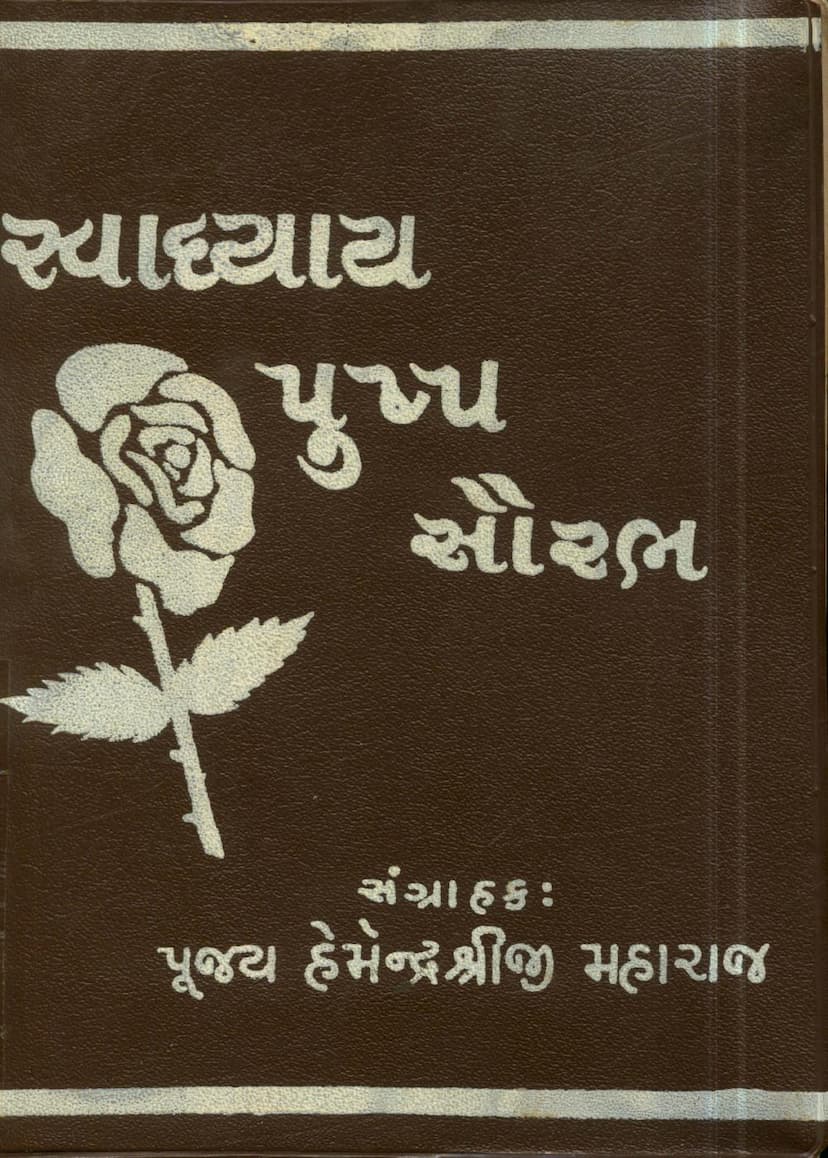Swadhyaya Pushp Saurabh
Added to library: September 2, 2025

Summary
This is a summary of the Jain text "Swadhyaya Pushp Saurabh" by Hemendrashreeji, published by Ghelabhai Karamchand Senetorium. The catalog link points to JainQQ.org, indicating it's a Jain religious text.
Here's a breakdown of the content based on the provided pages:
Overall Nature of the Text:
- "Swadhyaya Pushp Saurabh" (સ્વાધ્યાય પુષ્પ સૌરભ): The title itself suggests a collection of "Swadhyaya" (self-study, scripture study) in the form of "Pushp Saurabh" (fragrance of flowers), implying a beautiful and devotional compilation.
- Author: Pujya Hemendrashreeji Maharaj (પૂજ્ય હેમેન્દ્રશ્રીજી મહારાજ): This indicates the text is authored by a respected Jain Acharya or Sadhu/Sadhvi. The repeated mention of "Bilimorawala" (બીલીમોરાવાળા) suggests a connection to Bilimora, a place in Gujarat, India.
- Publisher: Ghelabhai Karamchand Senetorium (શેઠશ્રી ઘેલાભાઈ કરમચંદ સેનેટોરીયમ): This indicates a philanthropic or religious institution as the publisher, likely in Mumbai.
- Content: The vast majority of the provided text consists of stotras (devotional hymns), mantras, prayers, and detailed procedures for Jain rituals and practices. It appears to be a comprehensive guide for spiritual study and observance.
Key Sections and Themes:
-
Opening Salutations and Dedications:
- Pages 1-3: Basic title pages, author, publisher, and a small dedication ("Arpan" - અર્પણ) to God, highlighting the path of righteousness leading to liberation. It emphasizes the importance of virtuous conduct and surrendering to the Guru and the divine.
- Page 5: A detailed list of donors and inspiring figures, indicating financial support from various individuals and organizations for the publication, highlighting "Shrut Bhakti" (devotion to scriptures).
-
Biography and Glorification of the Author (Hemendrashreeji Maharaj):
- Pages 6, 8, 9: These pages seem to contain biographical details of Pujya Hemendrashreeji Maharaj, mentioning his birth in "Bambar Kote" (perhaps a place name, likely related to Bilimora), his observance of Brahmacharya from childhood, his taking vows at 16, his studies in various subjects like scriptures, logic, and grammar, and his prolific teaching and dissemination of Jainism. His parents, Virchandbhai and Diwali-ben, are also mentioned.
-
Core Jain Principles and Practices:
- Page 14-16: Importance of Knowledge (Samayag Gyan): This section emphasizes the crucial role of "Samyag Gyan" (right knowledge) in overcoming ignorance and achieving liberation. It contrasts with modern education that might erode traditional culture. Knowledge coupled with right action leads to Moksha (liberation).
- Page 17 onwards: Collection of Stotras, Mantras, and Rituals: This is the most substantial part of the text. It includes:
- Navkar Mantra (નવકાર મંત્ર): Mentioned on page 20 and elaborated on page 21 as "Atmaraksha Navkar Mantra" (आत्मरक्षा नवकार मंत्र) – a protective mantra.
- Mantras and Stotras: A long list of stotras and mantras are presented, often in Prakrit or Sanskrit, dedicated to various Tirthankaras (especially Parshvanath) and other Jain deities or practices. Examples include:
- Uvassagaharam Stotram (ઉવસગ્ગહરં સ્તવનમ) - Page 21
- Shantikar Stotram (સંતિકર સ્તવનમ) - Page 22
- Tijayapahutt Stotram (તિજયપહુર સ્તોત્રમ્) - Page 23
- Shri Sarvatobhadra Yantra (શ્રી સર્વતો ભદ્ર યંત્ર) - Page 24
- Ajita Shanti Stotram (અજિતશાંતિ સ્તવનમ્) - Page 28
- Bhaktamar Stotram (ભક્તામર સ્તોત્રમ) - Page 33
- Kalyan Mandir Stotram (શ્રી કલ્યાણ મંદિર સ્તોત્રમ્) - Page 39
- Shri Brahmashanti Stotram (શ્રી બ્રહચ્છાંતિ સ્તોત્રમ) - Page 26
- Shri Jinpanjar Stotram (શ્રી જિનપંજર સ્તોત્રમ) - Page 48
- Shri Parshvanath Stotram (શ્રી પાર્શ્વનાથ સ્તોત્ર) - Page 57
- Shri Rishimandal Stotram (શ્રી ઋષિમંડલ સ્તોત્રમ્) - Page 58
- Shri Ghantakaran Mahamantra (શ્રી ઘંટાકર્ણ મહામંત્ર) - Page 64
- Shri Graha Shanti Stotram (શ્રી ગ્રહશાંતિ સ્તોત્રમ્) - Page 65
- Shri Chaucharan Patra (શ્રી ચઉસરણ પત્ર) - Page 67
- Gautam Swami Ras (શ્રી ગૌતમસ્વામીને રાસ): A narrative poem about Gautam Swami, the chief disciple of Mahavir Swami.
- Punyaprakash Stotram (શ્રી પુણ્યપ્રકાશનું સ્તવન): Page 74 onwards, detailing merits and virtuous actions.
- Padmavati Aradhana (પદ્માવતી આરાધના): A section for worshipping the goddess Padmavati.
- Essential Jain Rituals: The text outlines various daily and periodic rituals:
- Devsik Pratikraman (દૈવસિક પ્રતિક્રમણ): Daily repentance.
- Rātrik Pratikraman (રાત્રિક પ્રતિક્રમણ): Nightly repentance.
- Pakshik Pratikraman (પાક્ષિક પ્રતિક્રમણ): Bi-weekly repentance.
- Chāumāsik Pratikraman (ચઉમાસી પ્રતિક્રમણ): Quarterly repentance.
- Samvatsari Pratikraman (સંવત્સરી પ્રતિક્રમણ): Annual repentance.
- Chaitra Vandan Vidhi (ચૈત્યવંદન વિધિ): Temple worship procedures.
- Perilehan Vidhi (પડિલેહણ વિધિ): Procedures for inspecting and cleaning utensils and clothes.
- Pachhakhan Vidhi (પચ્ચક્ખાન વિધિ): Procedures for taking vows and resolutions.
- Gochari Vidhi (ગોચરી આવવાની વિધિ): Rules for alms-gathering.
- Sutak Vichar (સૂતક વિચાર): Rules regarding ritual impurity due to birth or death.
- Mulpath of Dashavaikalik Sutra (દશવૈકાલિક સૂત્ર મૂલપાઠ): The root text of the Dashavaikalik Sutra, a fundamental scripture for monks and nuns.
Detailed Content Breakdown (from Table of Contents and page samples):
The extensive list of stotras and mantras suggests a focus on devotional practices, seeking divine grace for protection, peace, and spiritual advancement. The inclusion of detailed ritual procedures (like Pratikraman, Chaityavandan, Perilehan, etc.) signifies a practical guide for Jain laypeople and ascetics.
The biographical details of Pujya Hemendrashreeji Maharaj suggest a veneration of his spiritual achievements and his role as a guide. The emphasis on knowledge and its relationship to the "Ratnatrayi" (three jewels: Right Faith, Right Knowledge, Right Conduct) points to the intellectual and ethical foundations of Jainism.
In Essence:
"Swadhyaya Pushp Saurabh" appears to be a rich and comprehensive devotional and practical manual for Jain spiritual practice. It combines the philosophical underpinnings of Jainism (importance of knowledge, karma, soul purification) with detailed instructions for rituals, prayers, and hymns, all dedicated to the author's revered Guru and the Jain Tirthankaras. The text serves as a guide for self-study, spiritual discipline, and a means of fostering devotion within the Jain tradition.